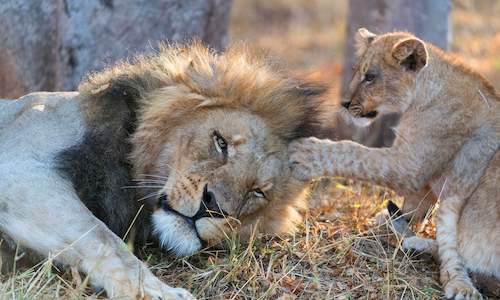
By Leigh Kemp
Symbiotic relationships are usually between two species but there may be more than two species involved in some cases. There are some interactions that are mistakenly presumed to be symbiotic - this misinterpretation coming from the fact that certain species are found together due to their similar habits and diets.Relationships in Feeding and Safety
Baboons and Impala are often seen together. Impala are one of the most common prey species for all predators and need to be constantly alert. Impala have good hearing and sight, snorting an alarm when sensing danger. Baboon sentries will use trees and Termite mounds to check for danger and bark an alarm when danger is sensed.This relationship takes a strange turn however when Impala are birthing and male Baboons prey on the young Antelope. When an animal perceives danger it will utter an alarm call which will alert all the other members of the group and other species in the area and these will then all assist in seeking out the danger.
This co-operation is not for the good of all but the for the survival of the individual and its group and although all the animals in the area work together the relationship is for self-preservation. However it could be argued that the initial alarm was to get all involved for the preservation of all of them.
Zebra and Wildebeest are found together on the African savanna grazing different parts of the same grass. The Zebra grazes the harder parts of the plant whereas the Wildebeest prefers the softer parts. A Zebra will move into an area of long grass before other herbivores and eat grass down to allow for new growth that is suitable for Wildebeest. Is this a symbiotic animal relationship or merely an interaction by design?Blood-sucking Birds
It was always considered that Oxpeckers formed a symbiotic relationship with the mammals they fed on, a mutually beneficial relationship, and when watching them feeding on ticks and other skin parasites it obvious that the benefits are there for both species. Not only do the birds help the animals limit parasites but they also warn the animals of danger by flying off screeching at danger.Recently, however, it has been discovered that Oxpeckers also pick at the wounds of animals, keeping them open and drinking the blood of the animals. This is semi-parasitic behaviour and the debate is whether the Oxpecker is of benefit or harm to its' host. Personal observations tend to point toward the fact that the feeding on wounds and blood, although not uncommon, is not the norm and therefore the relationship is still of benefit to both species.Eagles and Egrets
Another mammal / bird relationship is the cattle egret's association with species such as the Buffalo and Wildebeest. The egret will feed on insects disturbed by the animal moving and pick parasites off the animal. The Buffalo is the most common mammal that shares a relationship with the egret. Egrets will ride on the backs of Buffalo and can act as a warning system.Whilst based in the Okavango Delta in Botswana I witnessed a relationship between a Fish Eagle and Buffalo that brings up a few points of discussion. On a few occasions I observed a Fish Eagle sitting on the back of a Buffalo and staring into the water. On no occasion did I observe it catching anything.
When I was first informed of this behaviour by one of my colleagues my initial thought was that it was and egret sitting on the buffalo. Nobody had seen this before.
Each time I observed this the Buffalo was feeding far into the floodplain where the grass was long, hiding the water. There was no way for the Eagle to see that far from its perch so it had to get a better vantage point. What had happened to get the eagle to hunt in an area it would normally avoid? It must have been successful in the past to have repeated the action.
 Discover incredible insights into Botswana's wildlife behaviour, from predator-prey dynamics to migration habits. Explore how animal behavio...
Discover incredible insights into Botswana's wildlife behaviour, from predator-prey dynamics to migration habits. Explore how animal behavio...